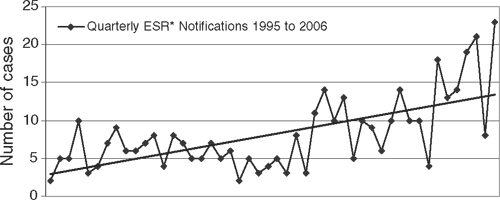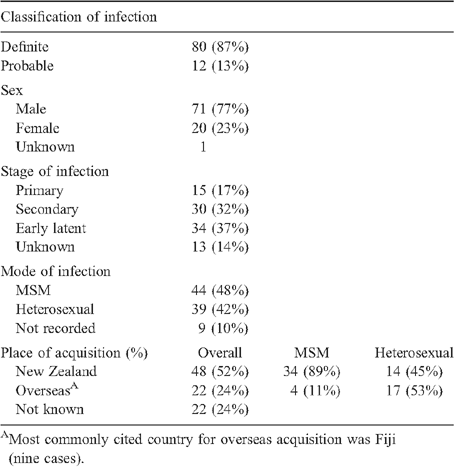Increase in incidence of infectious syphilis in Auckland, New Zealand: results from an enhanced surveillance survey
Sunita Azariah A D , Nicky Perkins A , Paul Austin B and Arthur J. Morris CA Auckland Sexual Health Service, Building 7, Private Bag 92024, Greenlane Clinical Centre, Auckland, New Zealand.
B Department of Virology and Immunology, LabPlus, Auckland City Hospital, Building 31, Level 2, Grafton, Auckland 1142, New Zealand.
C Diagnostic MedLab, PO Box 14743, Panmure, Auckland 1741, New Zealand.
D Corresponding author. Email: SunitaA@adhb.govt.nz
Sexual Health 5(3) 303-304 https://doi.org/10.1071/SH08015
Submitted: 14 February 2008 Accepted: 4 March 2008 Published: 6 August 2008
Abstract
We instigated an enhanced voluntary surveillance system to determine the epidemiology of infectious syphilis in Auckland because it is not a notifiable condition. The study took place over a 12-month period from July 2006 to July 2007. We identified 92 cases of infectious syphilis, of which 71 were male (77%). Forty-four (48%) cases were in men who have sex with men, who made up the biggest proportion. Forty-eight cases (52%) acquired their infection in New Zealand and only 48 of all identified cases were symptomatic (52%). Our results confirm that infectious syphilis incidence is currently under-reported.
Additional keywords: congenital syphilis, men who have sex with men.
Introduction
Since the late 1990s many countries, including New Zealand, have experienced a resurgence in the incidence of infectious syphilis.1–6 Syphilis is not a notifiable disease in New Zealand and national data is derived solely from voluntary sentinel site reporting, which shows a 300% increase since 1994 (Fig. 1).4 It is likely that the number of reported cases represents an underestimate of the true incidence. We therefore designed an enhanced syphilis surveillance survey to obtain an accurate picture of infectious syphilis in Auckland.

|
Methods
The study period was from July 2006 to July 2007 and the study was approved by the Northern Y Regional Ethics Committee.
Potential cases of infectious syphilis were identified from laboratory data from the only two laboratories carrying out serological testing for syphilis in Auckland. A confirmed diagnosis of syphilis required a reactive non-treponemal rapid plasma reagin test, as well as a reactive treponemal specific assay. In an attempt to exclude cases of late latent syphilis, cases that had not been evaluated by Auckland Sexual Health Service were included only if the rapid plasma reagin titre was greater than or equal to 1 : 8.
A data collection form was sent to all health practitioners who had patients meeting the inclusion criteria.
Results
During the 12 months, there were 92 definite or probable cases of infectious syphilis identified (Table 1), giving a crude regional incidence rate of 7.0 cases per 100 000. The questionnaire response rate was 87%. Probable cases were from survey non-responders where there was insufficient data available to confirm the diagnosis of infectious syphilis.

|
The age range of cases was 16 to 66 with a mean age of 33 and with a predominance of males (77%). Just over half of the cases were acquired within New Zealand (52%) (Table 1). The majority of cases (44) were in men who have sex with men, who were more likely than heterosexuals to have acquired their infection in New Zealand (Table 1).
The majority of cases (52%) presented with symptoms or signs of infectious syphilis, however, there was still a large proportion who were asymptomatic (43%). Only one of the 18 cases diagnosed following routine immigration screening had symptoms.
Only 41% of practitioners stated they were satisfied that all sexual contacts had been treated, due in part to many cases having untraceable anonymous sex partners.
Discussion
Auckland is experiencing an outbreak of infectious syphilis. Only 32 cases of infectious syphilis were reported in Auckland in 2006 by the sentinel site reporting system, giving a crude incidence rate of 2.4 per 100 000. Data from the present study gives a crude incidence rate of 7.0 per 100 000, confirming our suspicion of under-reporting. Our rate is a little higher than that recently reported from Wellington, 5.9 per 100 000 in 2006.5
It is of particular concern that the majority of the cases acquired within New Zealand were in men who have sex with men. However, 45% of heterosexual cases were also acquired locally and this could have the unwelcome consequence of a rise in the rates of congenital syphilis. A case of congenital syphilis has been recently reported in Auckland, in a baby born to a mother who had not had any antenatal care during that pregnancy.7
In summary we believe that it is essential that a coordinated regional strategy be developed to address the current syphilis epidemic. Central to this would be a formalised and improved syphilis surveillance system including laboratory data and anonymised case notification.
Conflict of interest
None declared.
[1] Righarts AA, Simms I, Solomou M, Fenton KA. Syphilis surveillance and epidemiology in the United Kingdom. Euro Surveill 2004; 9 21–5.
| CAS | PubMed | [Verified 27 March 2008]
[5] Cunningham R, MacDonald J, McLean M, Shaw C. An outbreak of infectious syphilis in Wellington, New Zealand. N Z Med J 2007; 120 U2680..
| PubMed |

[6] Azariah S. Is syphilis resurgent in New Zealand in the 21st century? A case series of infectious syphilis presenting to the Auckland Sexual Health Service. N Z Med J 2005; 118 U1349.
| PubMed |

[7] Battin M, Voss L. Beware of infants with rash, respiratory distress and hepatomagaly at birth: a case of congenital syphilis. N Z Med J 2007; 120 U2448.
| PubMed |



